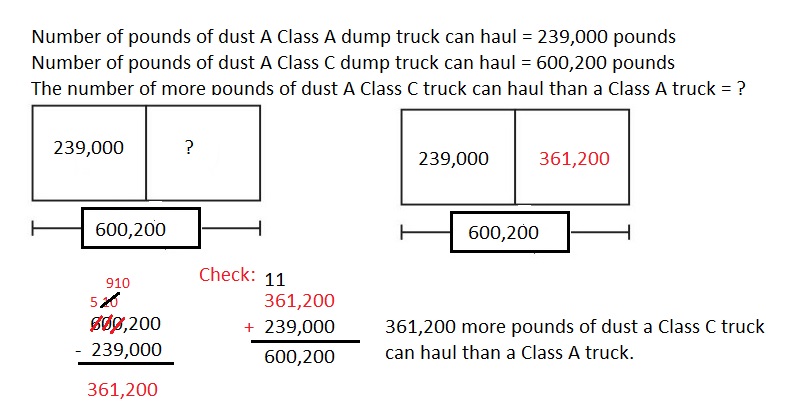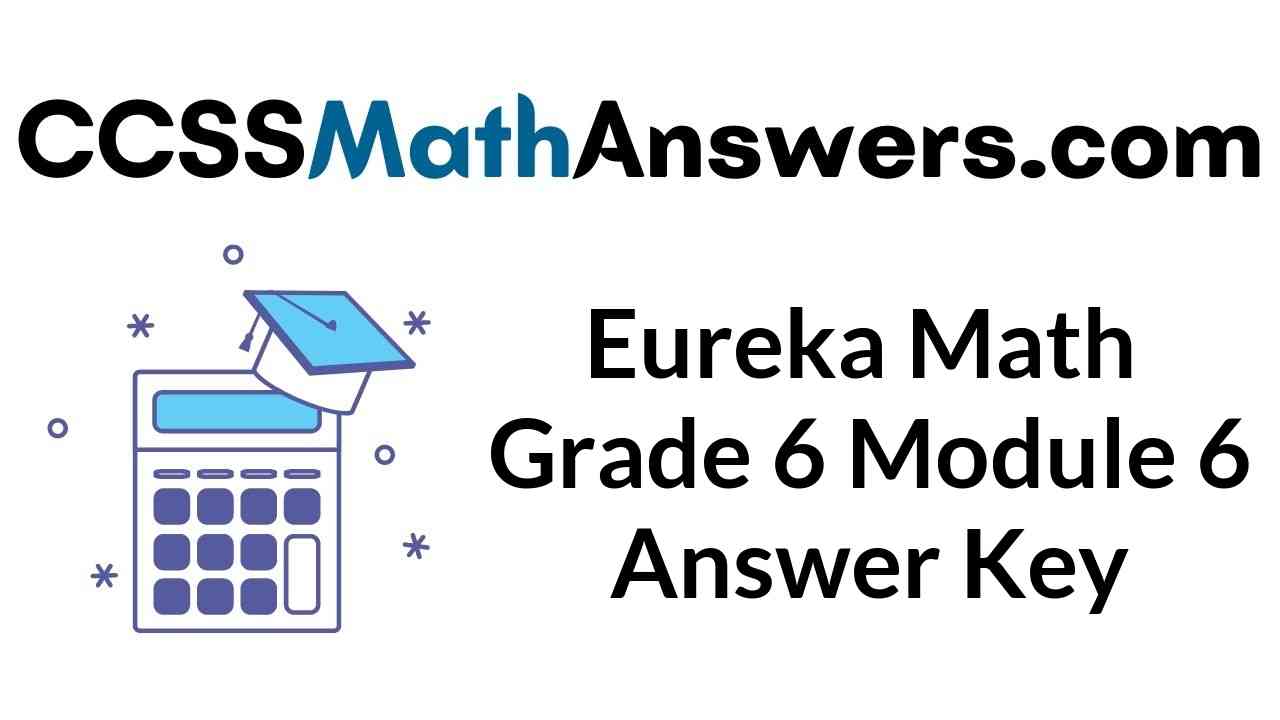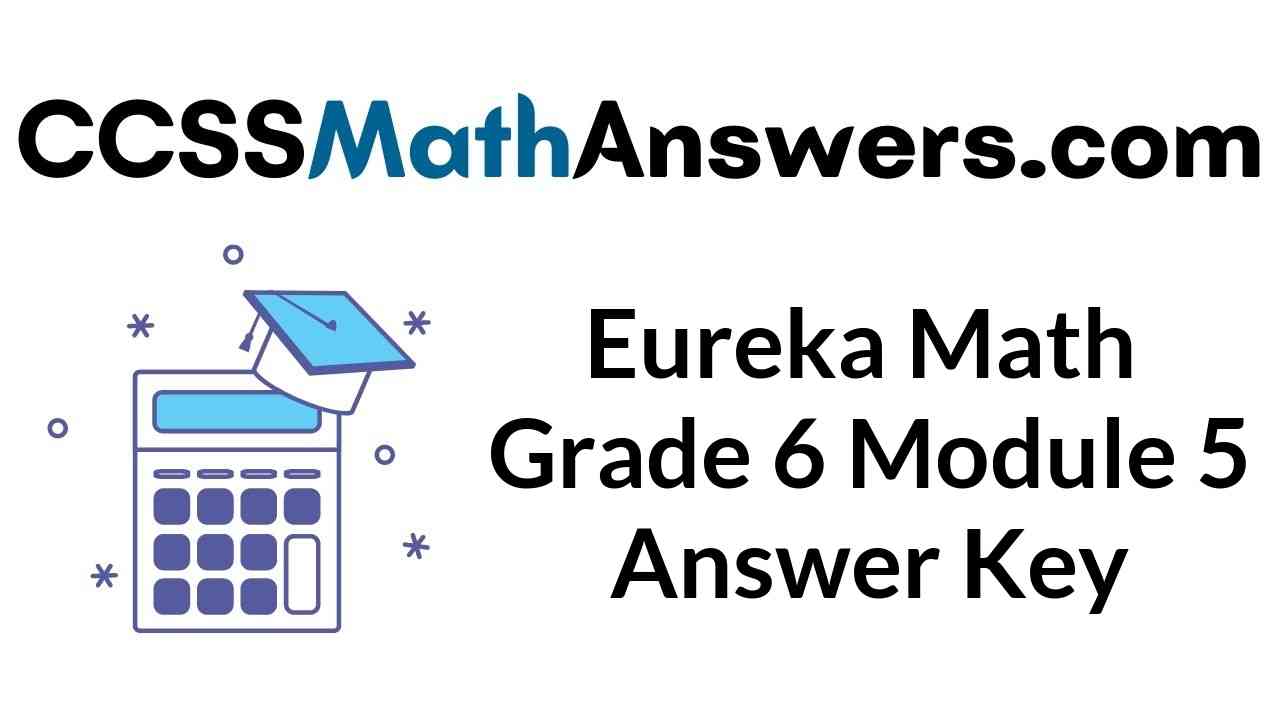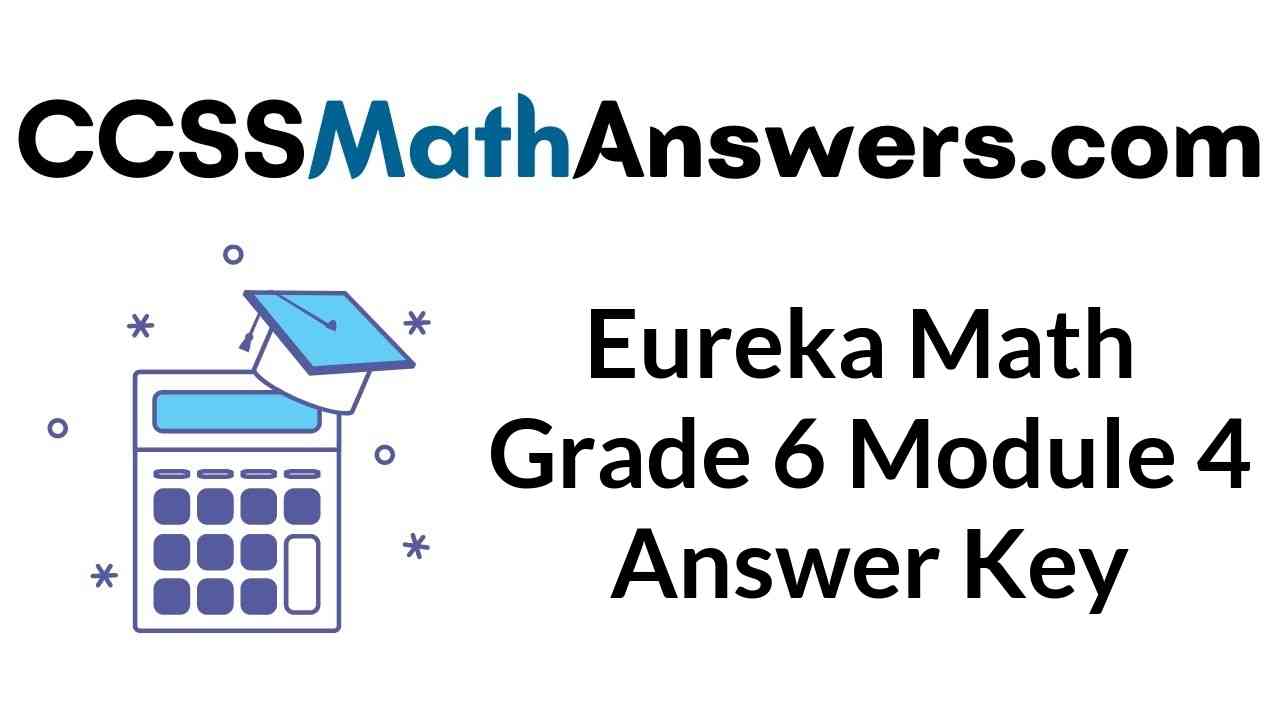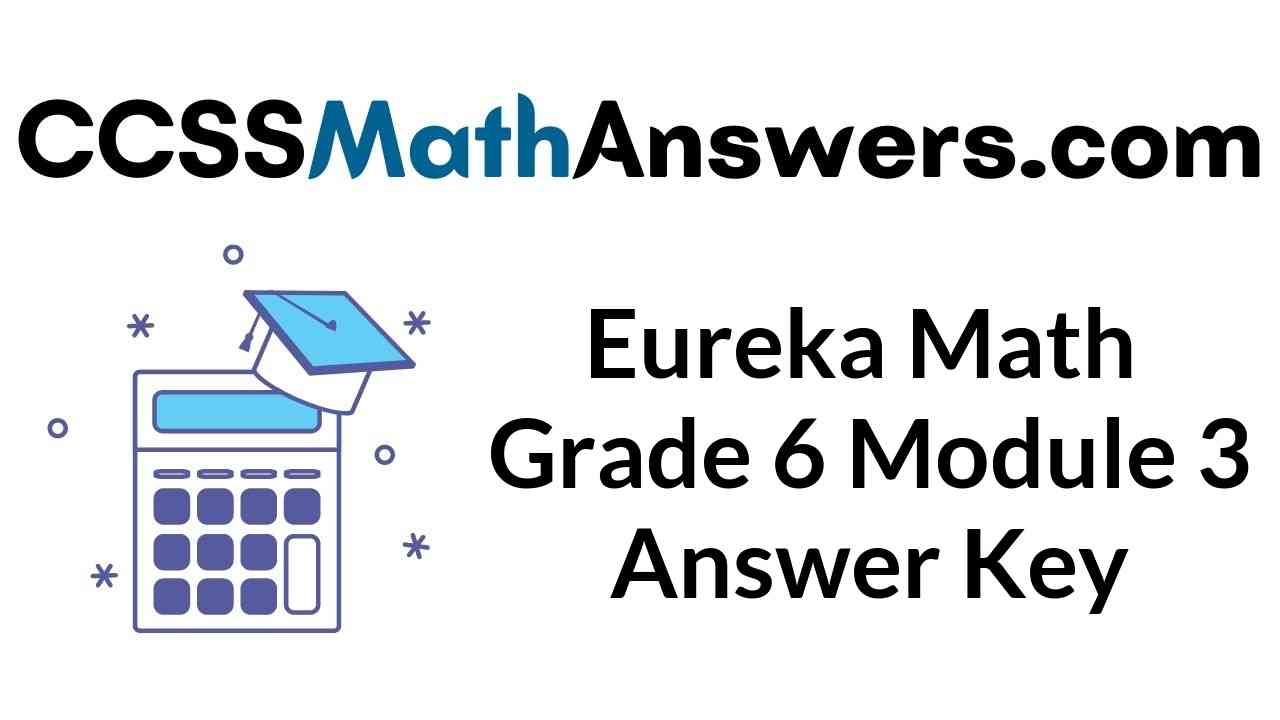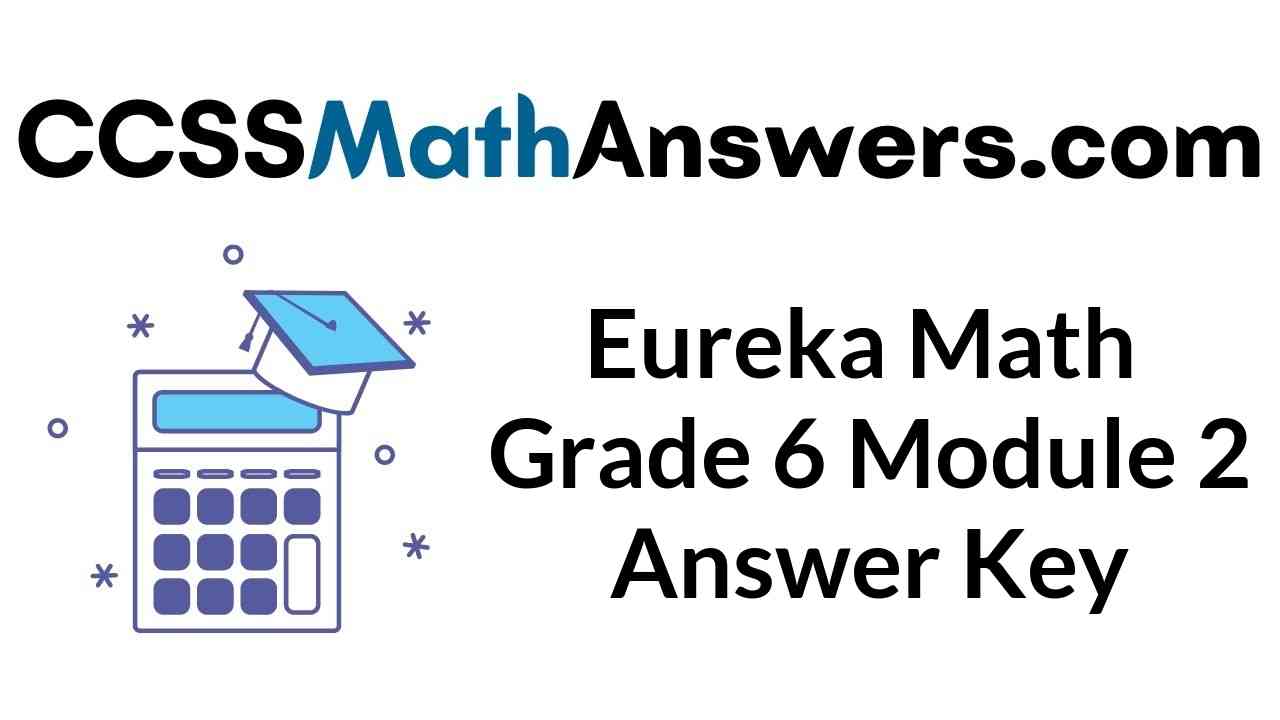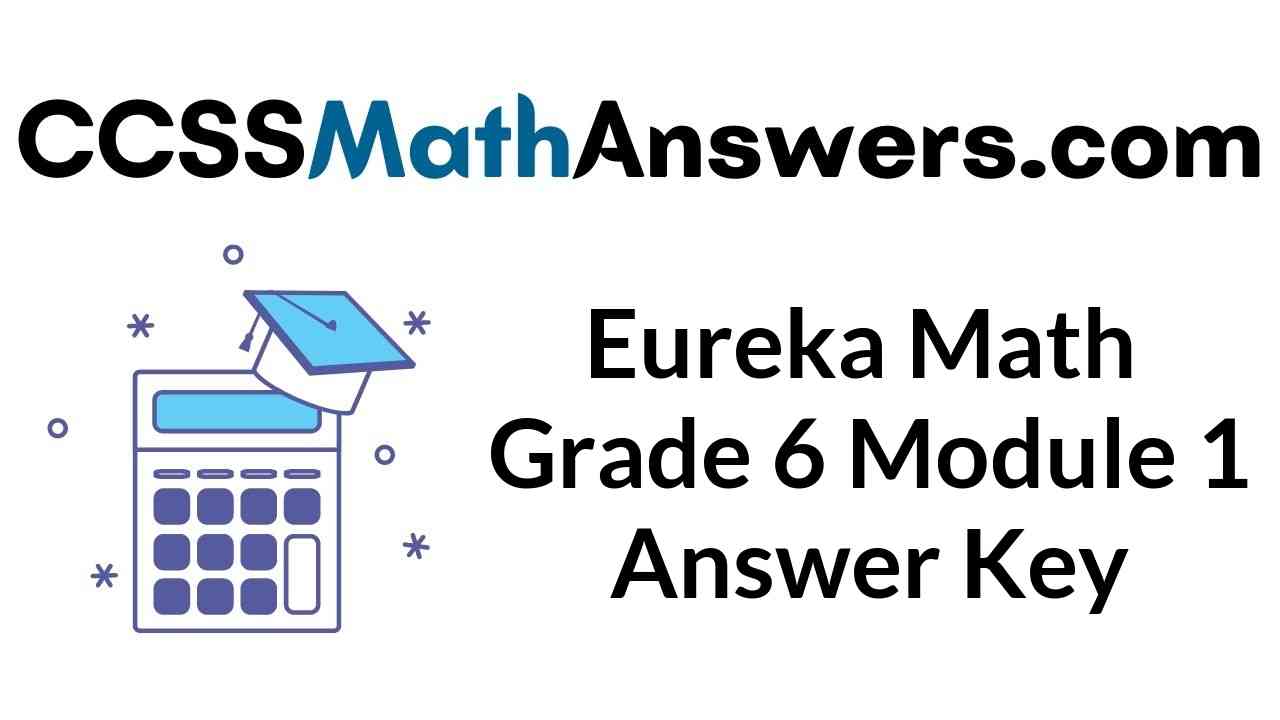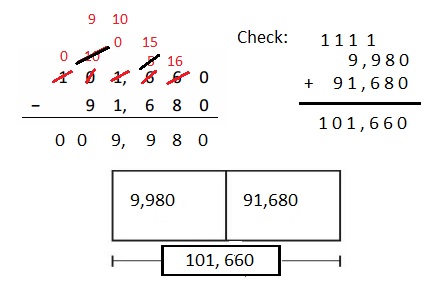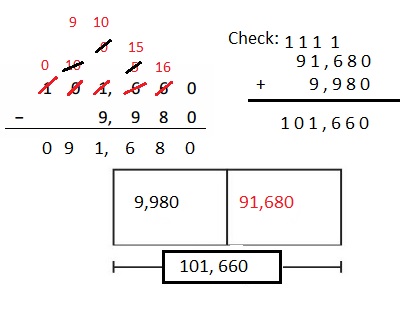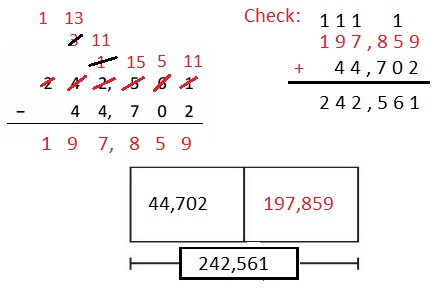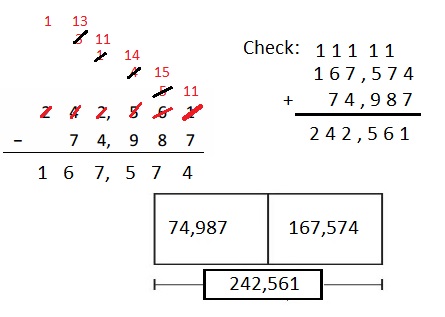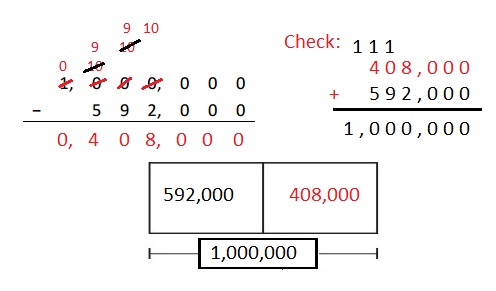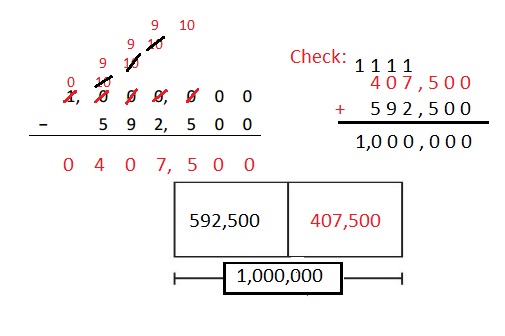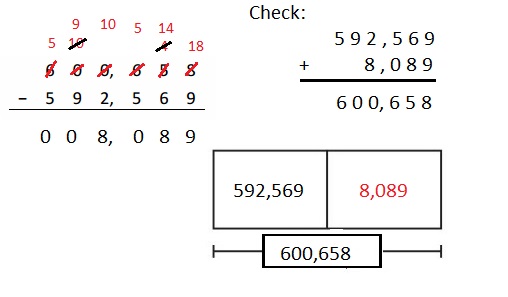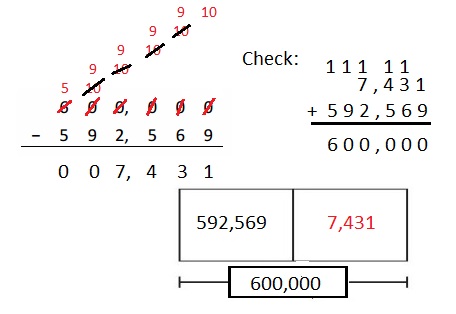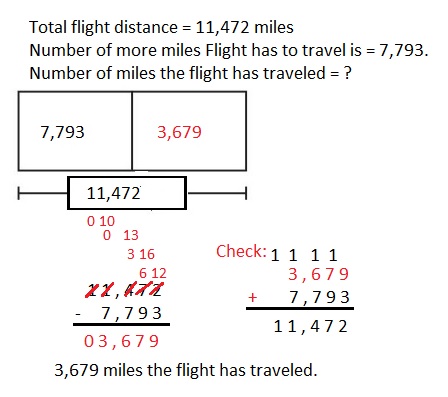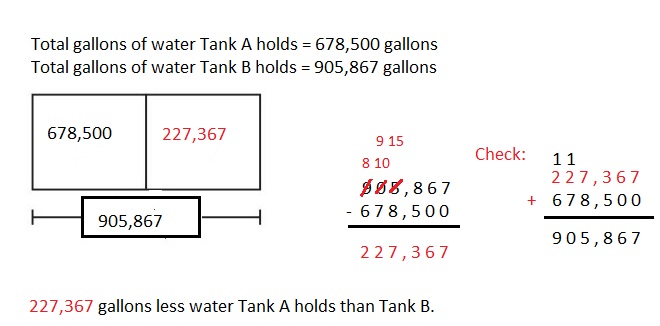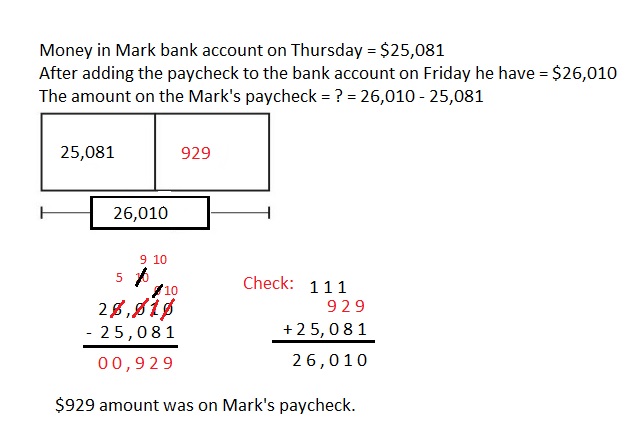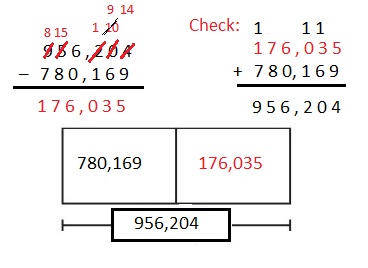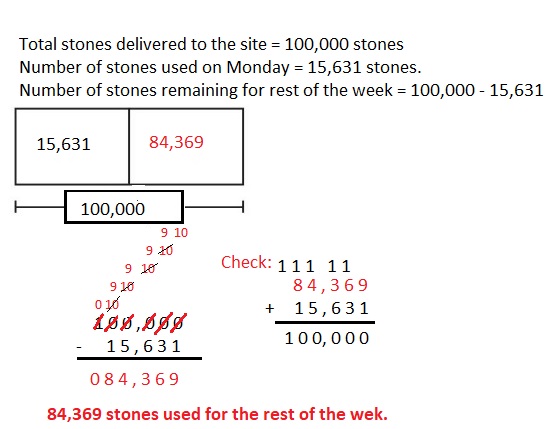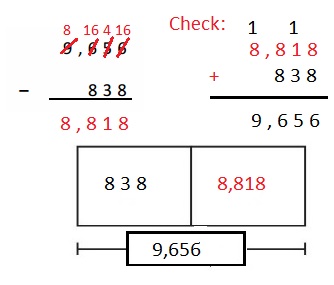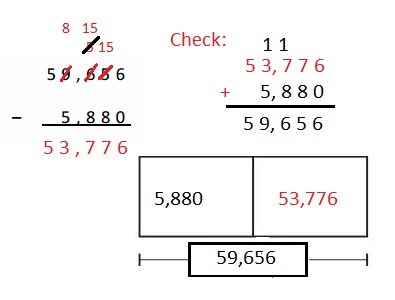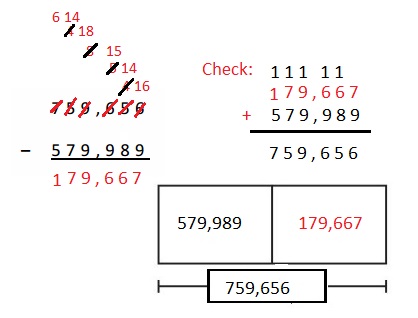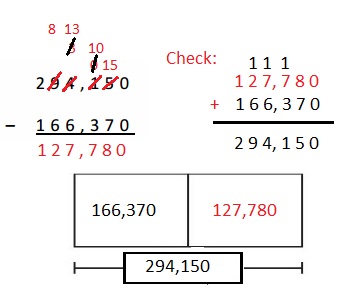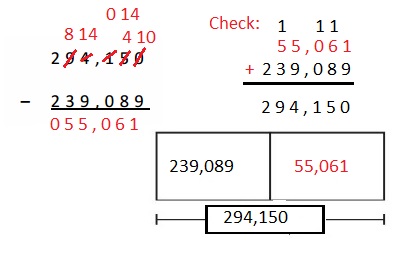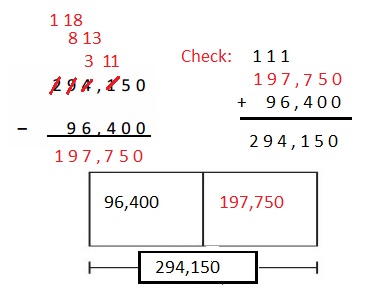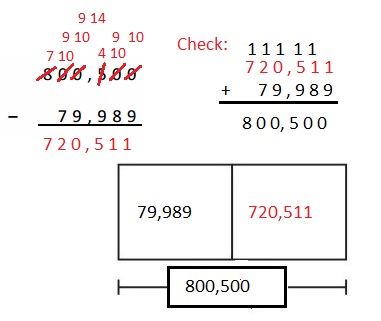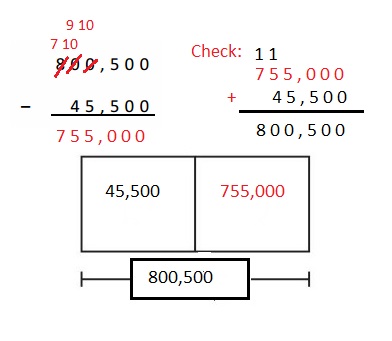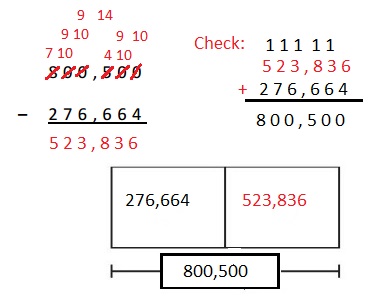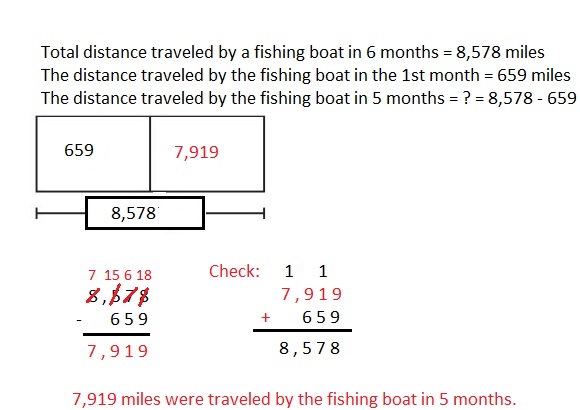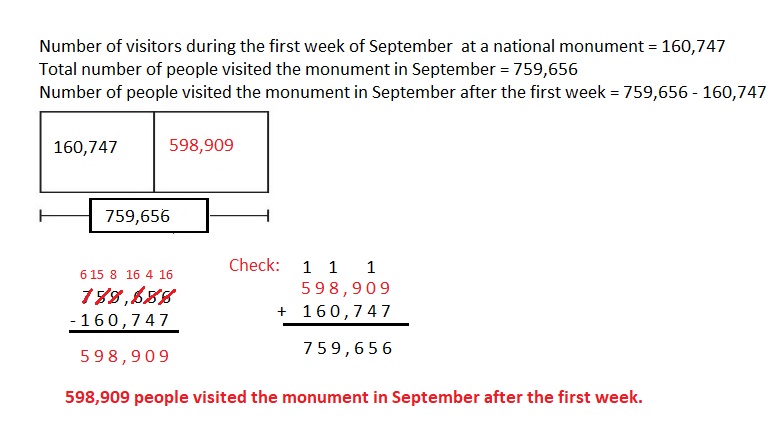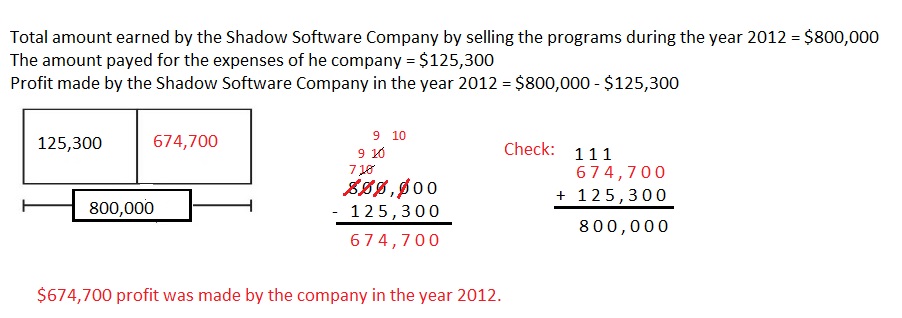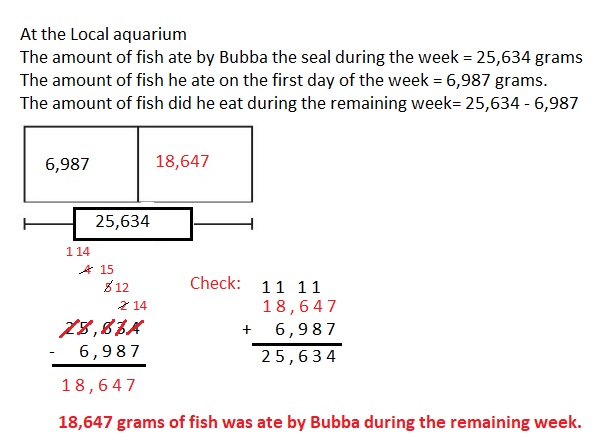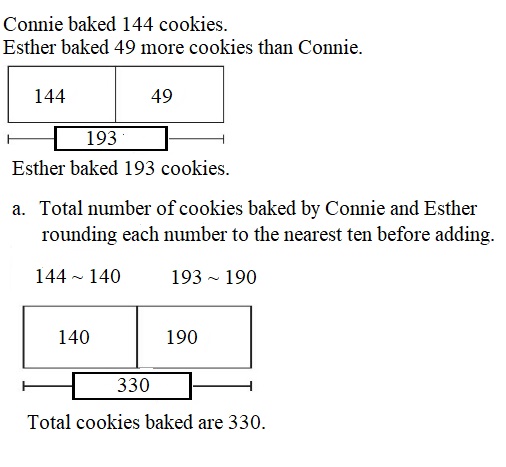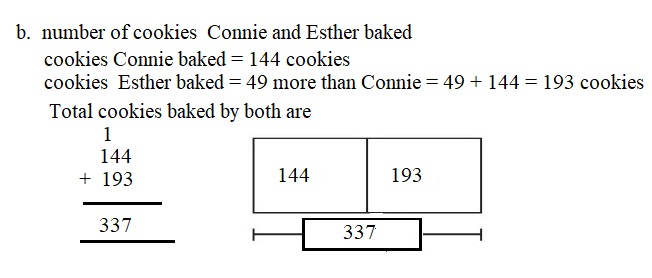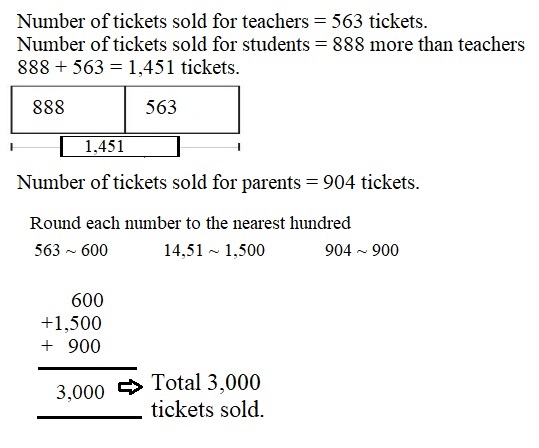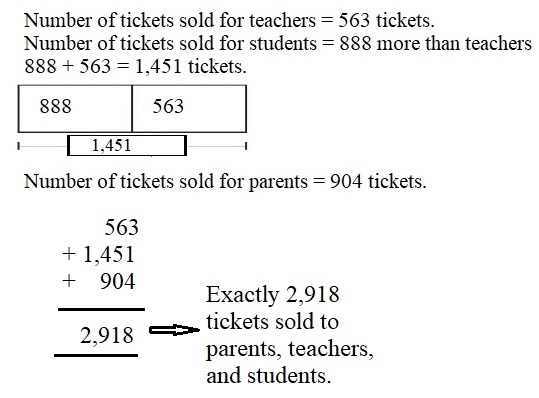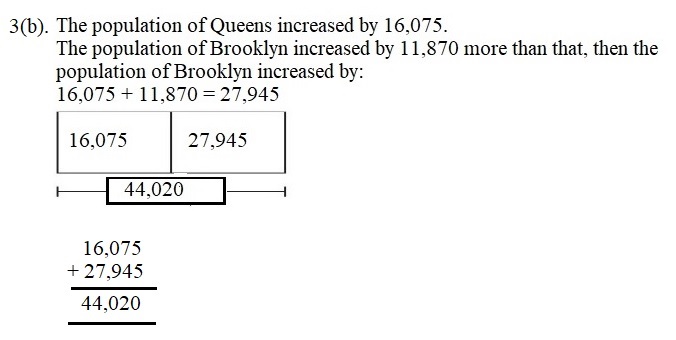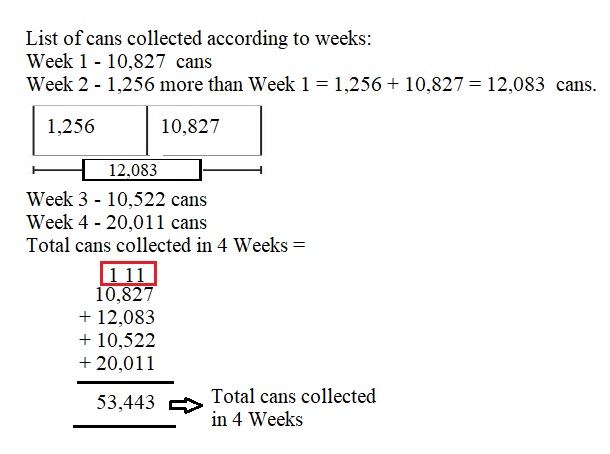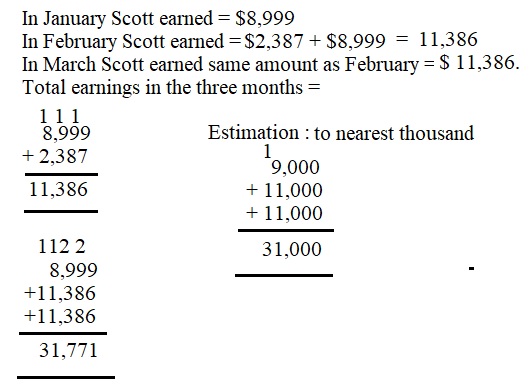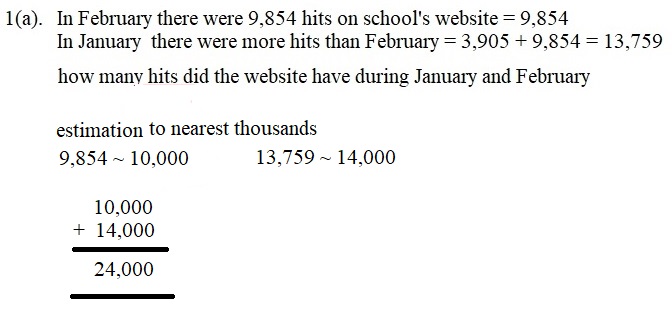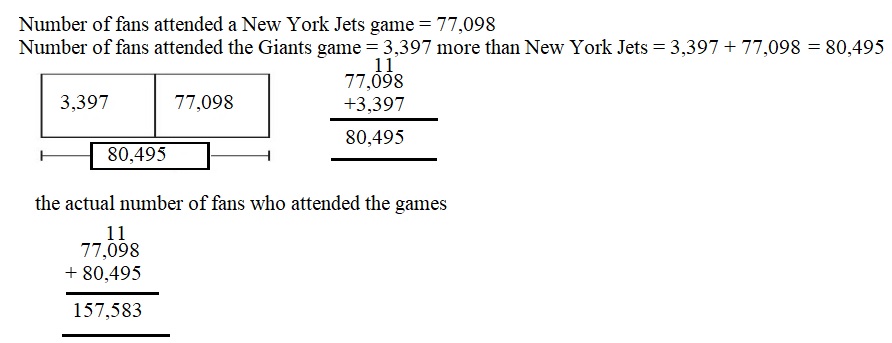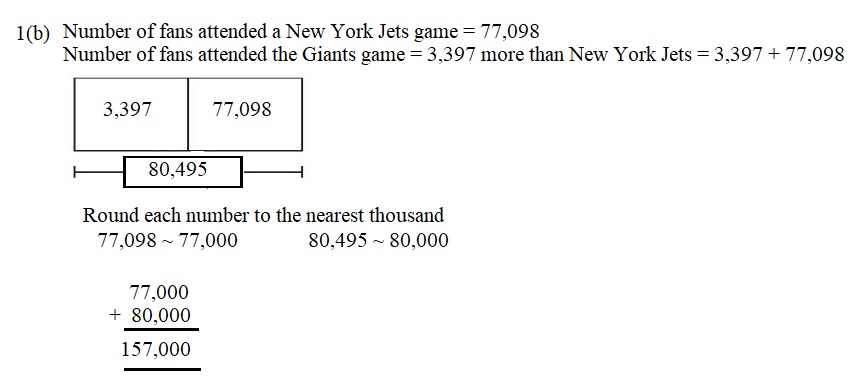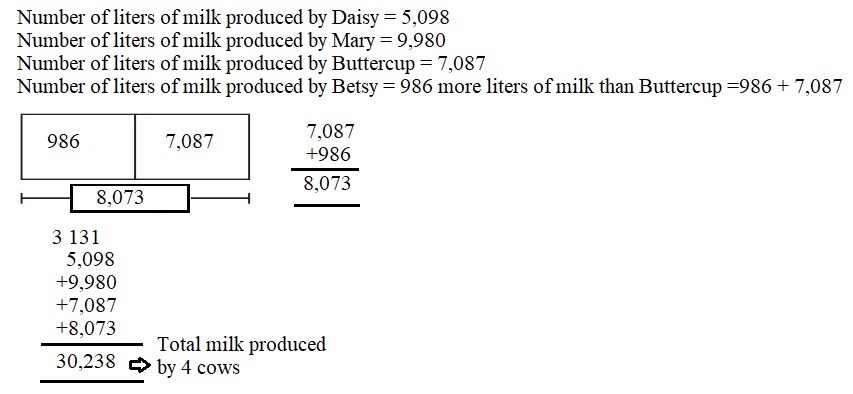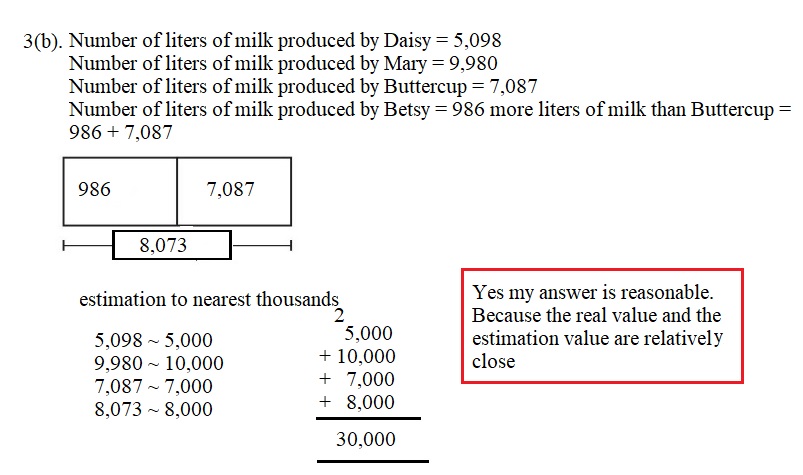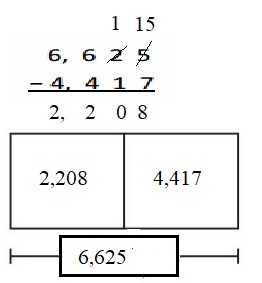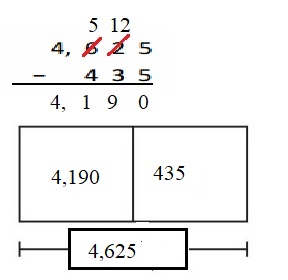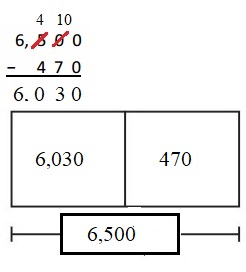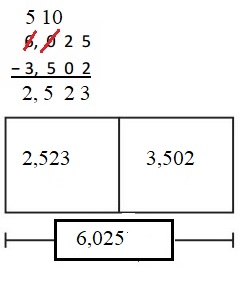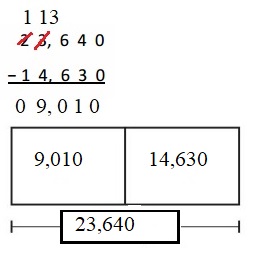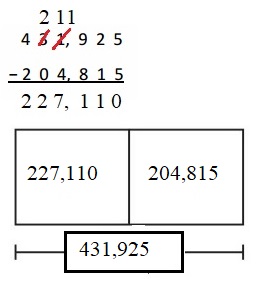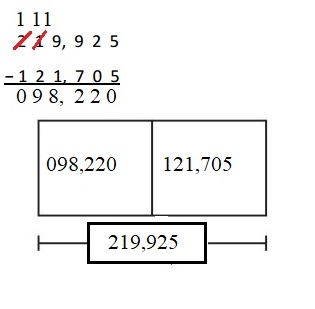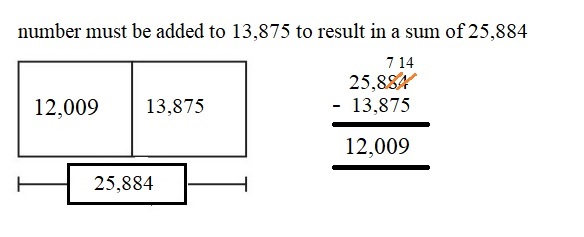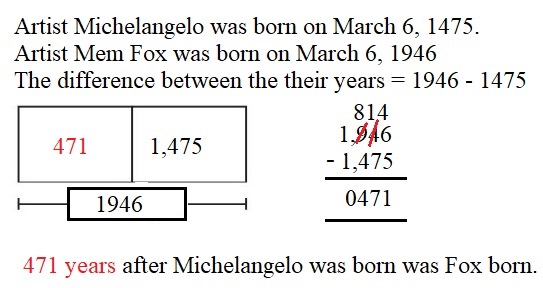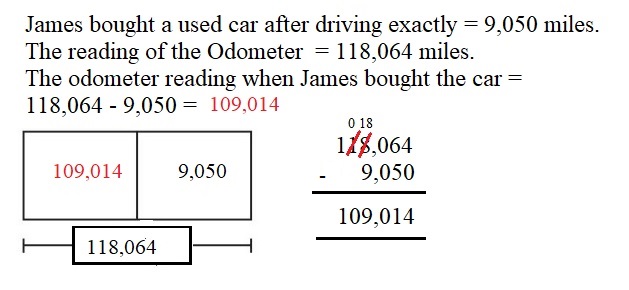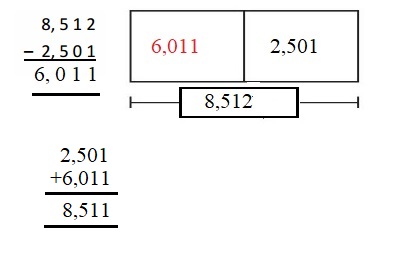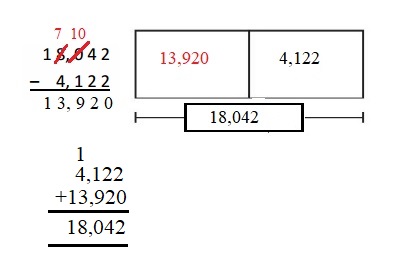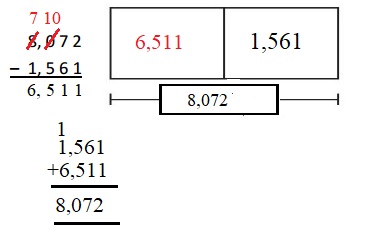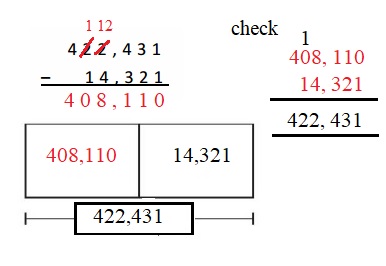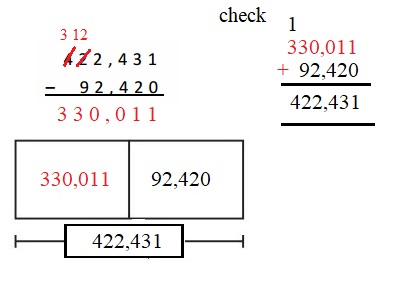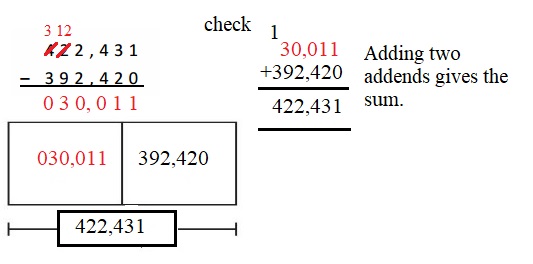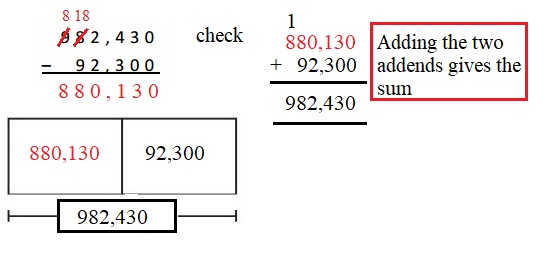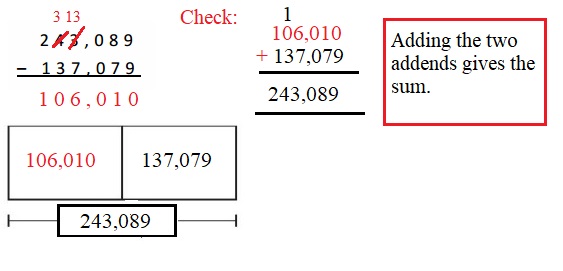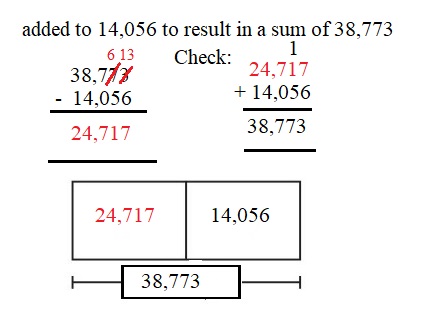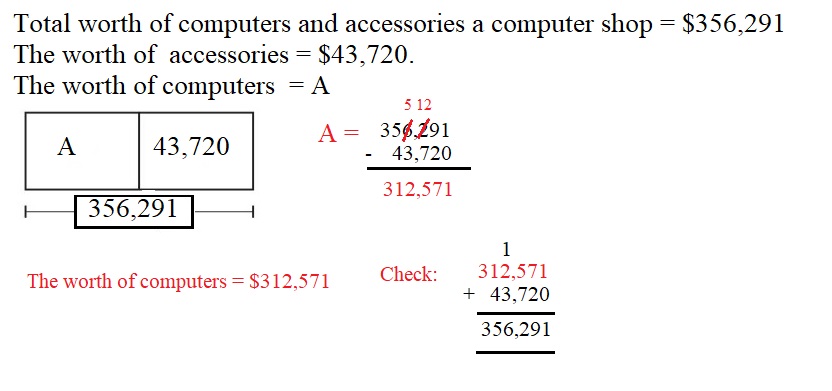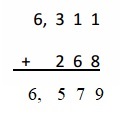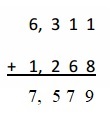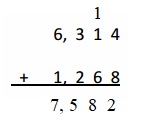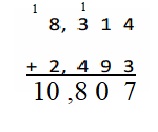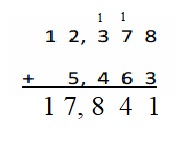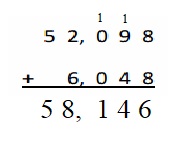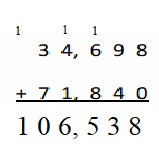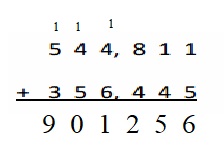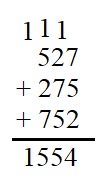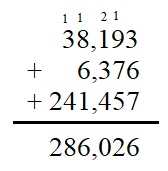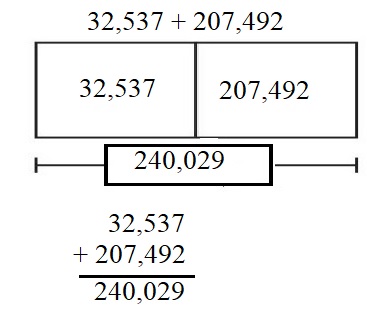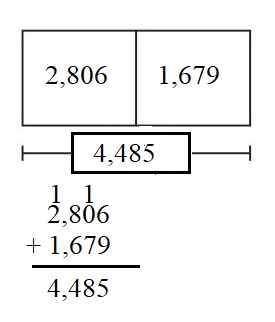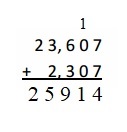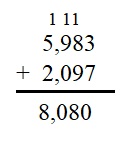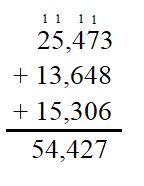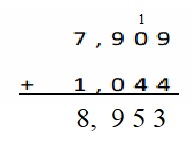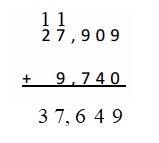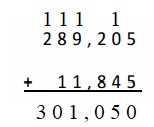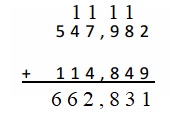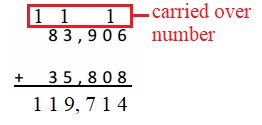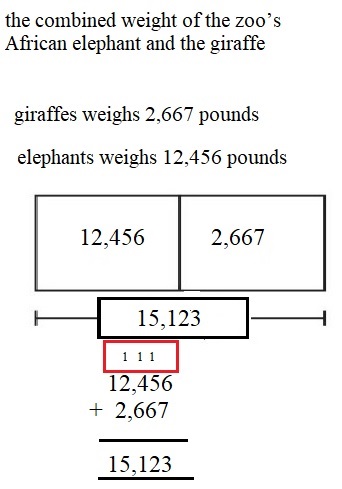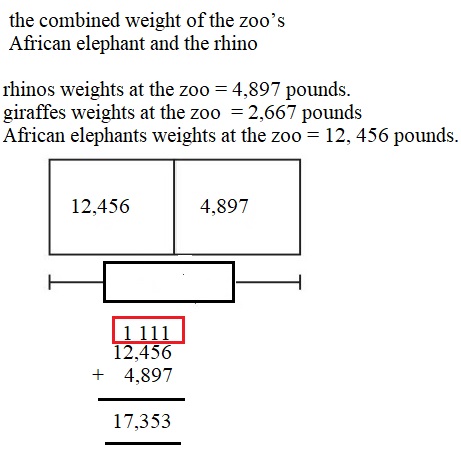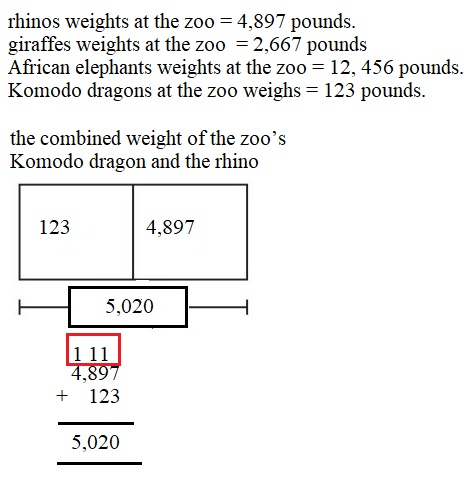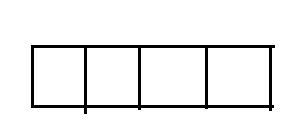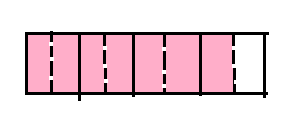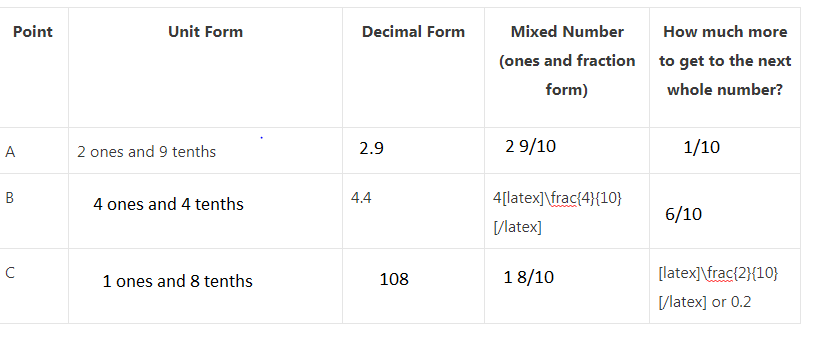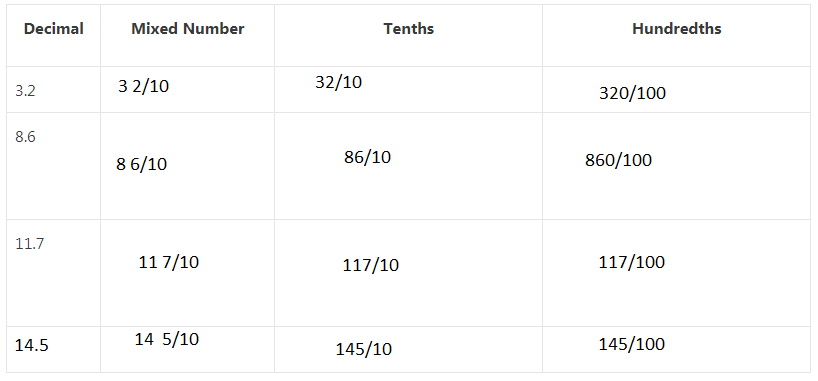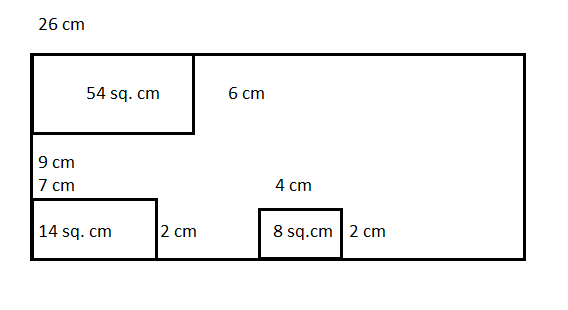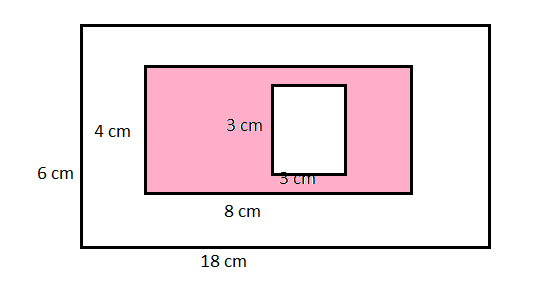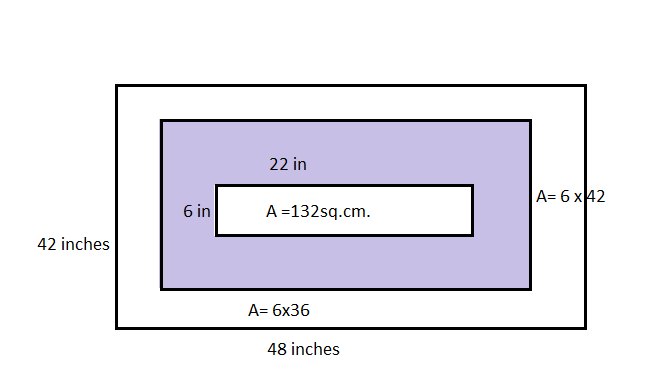Engage NY Eureka Math 4th Grade Module 1 Lesson 14 Answer Key
Eureka Math Grade 4 Module 1 Lesson 14 Problem Set Answer Key
Question 1.
Use the standard algorithm to solve the following subtraction problems.
a. 
Answer:
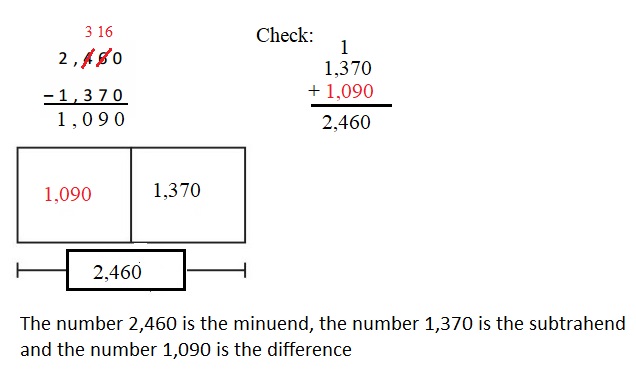
b. 
Answer:
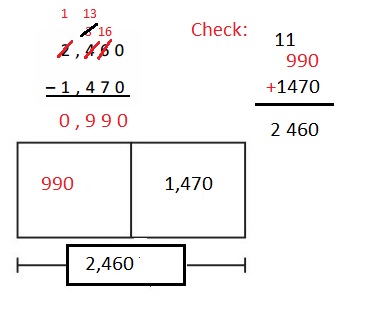
Explanation:
The rules of subtraction we first write the greater number at the top. Then subtract the digits column-wise ones from ones, tens from tens, hundreds from hundreds, thousands from thousands and so on.
Ones = 0 – 0 = 0.
Tens = 6 – 7 = 16 – 7 = 9.
6 is less than 7 so we borrow 1 from the 4 hundred place and make 4 hundred as 3 hundred and make 6 ten as 16 ten and we subtract 7 from 16.
Hundreds = After borrowing 1 from hundred 4 becomes 3 . 3 – 4 = 13 – 4 = 9.
3 is less than 4 so we again borrow 1 from the 2 Thousands place and make 2 Thousands as 1 Thousands and make 3 hundreds as 13 hundreds and we subtract 4 from 13.
Thousands = 1 – 1 = 0
The number 2,460 is the minuend, the number 1,470 is the subtrahend and the number 990 is the difference.
c. 
Answer:
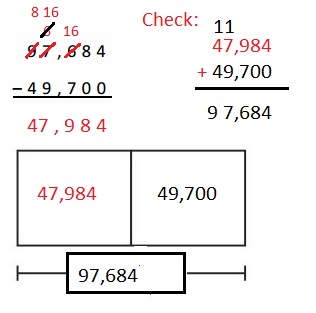
Explanation:
The rules of subtraction we first write the greater number at the top. Then subtract the digits column-wise ones from ones, tens from tens, hundreds from hundreds, thousands from thousands and so on.
Ones = 4 – 0 = 4.
Tens = 8 – 0 = 8.
Hundreds = 6 – 7 = 16 – 7 = 9.
6 is less than 7 so we borrow 1 from the 7 thousands place and make 7 thousands as 6 thousands and make 6 hundreds as 16 hundreds and we subtract 7 from 16.
Thousands =After borrowing 1 from thousands place 7 becomes 6. 6 – 9 = 16 – 9 = 7.
6 is less than 9 so we again borrow 1 from the 9 ten thousands place and make 9 ten thousands as 8 ten thousands and make 6 thousands as 16 thousands and we subtract 9 from 16.
Ten Thousands = 8 – 4 = 4.
The number 97,684 is the minuend, the number 49,700 is the subtrahend and the number 47,984 is the difference.
d. 
Answer:
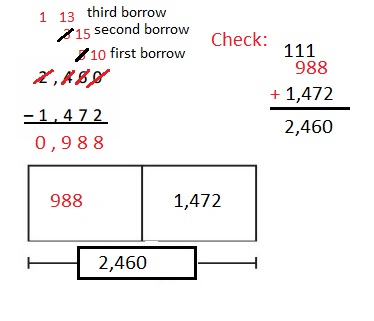
Explanation:
The rules of subtraction we first write the greater number at the top. Then subtract the digits column-wise ones from ones, tens from tens, hundreds from hundreds, thousands from thousands and so on.
Ones = 0 – 2 = 10 – 2 = 8.
0 is less than 2 so we borrow 1 from the 6 tens place and make 6 tens as 5 tens and make 0 ones as 10 ones and we subtract 2 from 10.
Tens =After borrowing 1 from tens place 6 becomes 5. 5 – 7 = 15 – 7 = 8.
5 is less than 7 so we borrow 1 from the 4 hundred place and make 4 hundred as 3 hundred and make 5 tens as 15 tens and we subtract 7 from 15.
Hundreds = After borrowing 1 from hundred 4 becomes 3 . 3 – 4 = 13 – 4 = 9.
3 is less than 4 so we borrow 1 from the 2 Thousands place and make 2 Thousands as 1 Thousands and make 3 hundreds as 13 hundreds and we subtract 4 from 13.
Thousands = 1 – 1 = 0
The number 2,460 is the minuend, the number 1,472 is the subtrahend and the number 988 is the difference.
e. 
Answer:
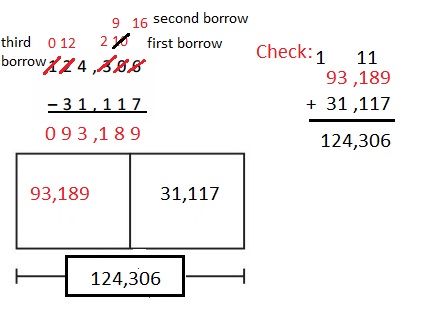
Explanation:
The rules of subtraction we first write the greater number at the top. Then subtract the digits column-wise ones from ones, tens from tens, hundreds from hundreds, thousands from thousands and so on.
Since, ones place and tens place values are less then the subtrahend we borrow 1 from the hundreds place and increase the value of tens.
Tens =After borrowing 1 from hundreds place 0 ten becomes 10 ten. So, After borrowing 1 from the 3 hundred place. 3 hundred becomes 2 hundred .
Ones = 6 – 7 = 16 – 7 = 9.
6 is less than 7 so we borrow 1 from the 10 tens place and make 10 tens as 9 tens and make 6 ones as 16 ones and we subtract 7 from 16.
Tens : After borrowing 1 from tens place. 10 becomes 9. 9 – 1 = 8.
Hundreds = After borrowing 1 from hundred 3 becomes 2 . 2 – 1 = 1.
Thousands : 4 – 1 = 3.
Ten Thousand : 2 – 3 = 12 – 3 = 9.
2 is less than 3 so we borrow 1 from the 1 hundred Thousands place and make 1 hundred Thousands as 0 hundred Thousands and make 2 thousand as 12 thousand and we subtract 3 from 12.
Hundred thousands = 0.
The number 124,306 is the minuend, the number 31,117 is the subtrahend and the number 93,189 is the difference.
f. 
Answer:
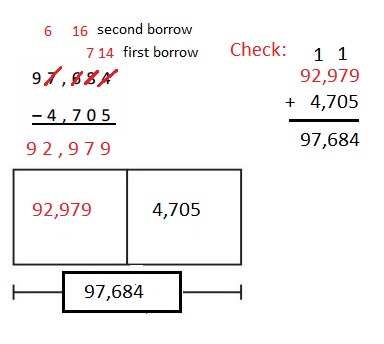
Explanation:
The rules of subtraction we first write the greater number at the top. Then subtract the digits column-wise ones from ones, tens from tens, hundreds from hundreds, thousands from thousands and so on.
Ones = 4 – 5 = 14 – 5 = 9.
4 is less than 5 so we borrow 1 from the 8 hundred place and make 8 hundred as 7 hundred and make 4 ten as 14 ten and we subtract 5 from 14.
Tens = 7 – 0 = 7
Hundreds =6 – 7 = 16 – 7 = 9
6 is less than 7 so we borrow 1 from the 7 Thousands place and make 7 Thousands as 6 Thousands and make 6 hundreds as 16 hundreds and we subtract 7 from 16.
Thousands = 6 – 4 = 2
Ten Thousand = 9.
The number 97,684 is the minuend, the number 4,705 is the subtrahend and the number 92,979 is the difference.
g. 
Answer:
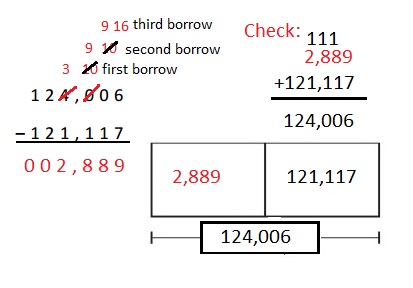
Explanation:
The rules of subtraction we first write the greater number at the top. Then subtract the digits column-wise ones from ones, tens from tens, hundreds from hundreds, thousands from thousands and so on.
The minuend ones , tens , hundreds all the three places are less then the subtrahend.
First
Ones = 6 – 7 = 16 – 7 = 9.
6 is less than 7 so we borrow 1 from the 0 ten place and make 0 tens as 9 tens and make 6 ones as 16 ones and we subtract 7 from 16.
Tens = After borrowing 1 from hundred 0 becomes 9. 9 -1 = 8.
Hundreds = After borrowing 1 from thousand 0 becomes 9 . 9 – 1 = 8.
Thousands = 3 – 1 = 2.
Ten thousand = 2 – 2 = 0.
Hundred thousand = 1 – 1 = 0.
The number 124,006 is the minuend, the number 121,117 is the subtrahend and the number 2,889 is the difference.
h. 
Answer:
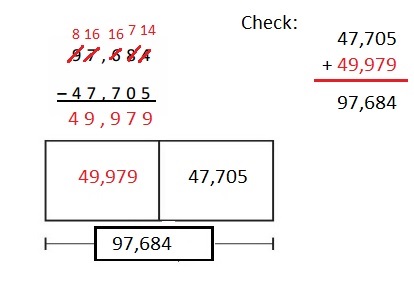
Explanation:
The rules of subtraction we first write the greater number at the top. Then subtract the digits column-wise ones from ones, tens from tens, hundreds from hundreds, thousands from thousands and so on.
Ones = 4 – 5 = 14 – 5 = 9.
4 is less than 5 so we borrow 1 from the 8 Tens place and make 8 Tens as 7 Tens and make 6 ones as 16 ones and we subtract 5 from 14.
Tens = 7 – 0 = 7.
Hundreds = 6 – 7 = 16 – 7 = 9.
6 is less than 7 so we borrow 1 from the 7 Thousands place and make 7 Thousands as 6 Thousands and make 6 hundreds as 16 hundreds and we subtract 7 from 16.
Thousands = 6 – 7 = 16 – 7 = 9.
6 is less than 7 so we borrow 1 from the 9 ten Thousands place and make 9 ten Thousands as 8 ten Thousands and make 6 hundreds as 16 hundreds and we subtract 7 from 16.
ten thousand = 8 – 4 = 4.
The number 97,684 is the minuend, the number 47,705 is the subtrahend and the number 49,979 is the difference.
i. 
Answer:
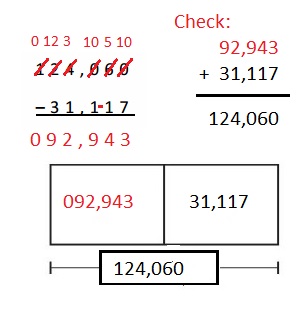
Explanation:
The rules of subtraction we first write the greater number at the top. Then subtract the digits column-wise ones from ones, tens from tens, hundreds from hundreds, thousands from thousands and so on.
Ones = 0 – 7 = 10 – 7 = 3.
0 is less than 7 so we borrow 1 from the 6 Tens place and make 6 Tens as 5 Tens and make 0 ones as 10 ones and we subtract 7 from 10.
Tens = 5 – 1 = 4.
Hundreds =0 – 1 = 1 – 1 = 9.
0 is less than 1 so we borrow 1 from the 4 Thousands place and make 4 Thousands as 3 Thousands and make 0 hundreds as 10 hundreds and we subtract 1 from 10.
Thousands = 3 – 1 = 2.
Ten thousand= 2 – 3 = 12 – 3 = 9.
2 is less than 3 so we borrow 1 from the 1 hundred Thousands place and make 1 hundred Thousands as 0 hundred Thousands and make 2 ten thousand as 12 ten thousand and we subtract 3 from 12.
The number 124,060 is the minuend, the number 31,117 is the subtrahend and the number 92,943 is the difference.
Draw a tape diagram to represent each problem. Use numbers to solve, and write your answer as a statement. Check your answers.
Question 2.
There are 86,400 seconds in one day. If Mr. Liegel is at work for 28,800 seconds a day, how many seconds a day is he away from work?
Answer:
Total seconds in one day = 86,400
Number of seconds Mr. Liegel at work in a day = 28,800
Number of seconds Mr. Leigel away from work = 86,400 – 28,800
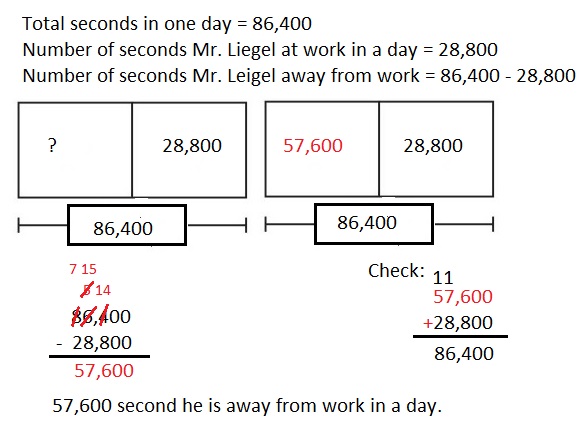
Question 3.
A newspaper company delivered 240,900 newspapers before 6 a.m. on Sunday. There were a total of 525,600 newspapers to deliver. How many more newspapers needed to be delivered on Sunday?
Answer:
Number of newspapers delivered by the company on Sunday before 6 a.m = 240,900
Total number of newspapers to be delivered = 525,600.
How many more newspaper to be delivered= ?
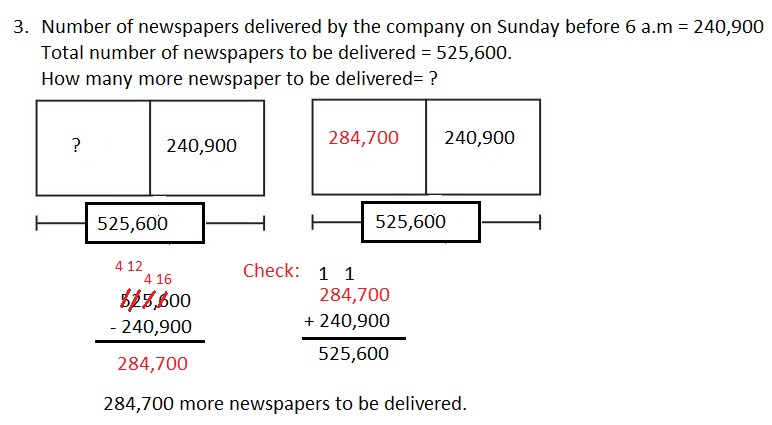
Question 4.
A theater holds a total of 2,013 chairs. 197 chairs are in the VIP section. How many chairs are not in the VIP section?
Total number of chairs a theater holds = 2,013
Number of chairs in the VIP Section = 197
Number of chairs which are not in the VIP section = B
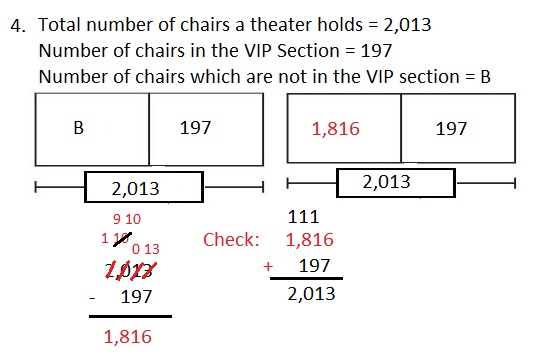
Question 5.
Chuck’s mom spent $19,155 on a new car. She had $30,064 in her bank account. How much money does Chuck’s mom have after buying the car?
Answer:
Money spent by Chuck’s mom on new car = $19,155
Total money she had in her bank account = $30,064
Money left with her after buying the car = 30,064 – 19,155
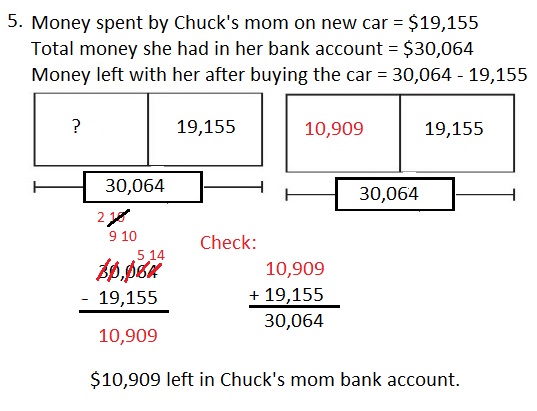
Eureka Math Grade 4 Module 1 Lesson 14 Exit Ticket Answer Key
Use the standard algorithm to solve the following subtraction problems.
Question 1.

Answer:
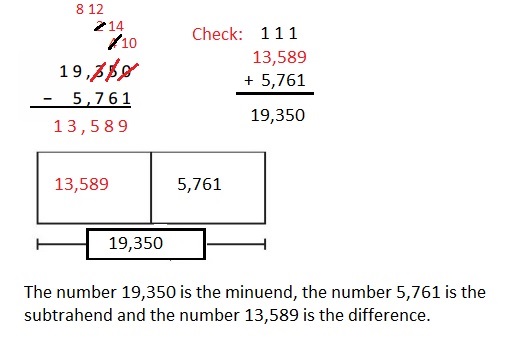
Question 2.
32,010 – 2,546
Answer:

Draw a tape diagram to represent the following problem. Use numbers to solve, and write your answer as a statement. Check your answer.
Question 3.
A doughnut shop sold 1,232 doughnuts in one day. If they sold 876 doughnuts in the morning, how many doughnuts were sold during the rest of the day?
Answer:
Total doughnut sold by the doughnut shop in one day = 1,232
Number of doughnuts sold in the morning = 876
Number of doughnuts sold during the rest of the day = A
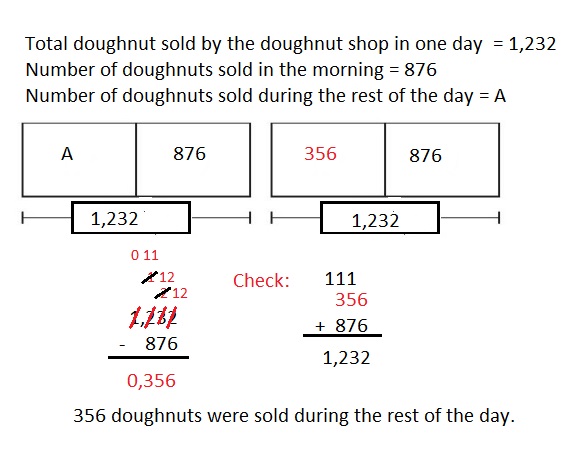
Eureka Math Grade 4 Module 1 Lesson 14 Homework Answer Key
Question 1.
Use the standard algorithm to solve the following subtraction problems.
a. 
Answer:
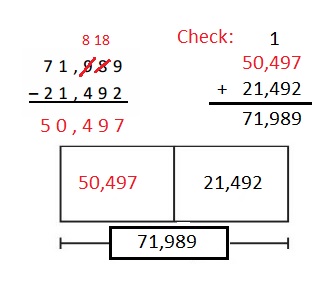
Explanation:
In subtraction if the minuend place values are less than the subtrahend then 1 is borrowed from the higher place value like
ones borrow from tens
tens borrow from hundreds
hundreds borrow from thousands
thousands borrow from ten thousands
ten thousands borrow from hundred thousands
hundred thousands borrow from million.
if there are successive place values less than the subtrahend we borrow from the highest place value whose value is higher than the subtrahend.
The number 71,989 is the minuend, the number 21,492 is the subtrahend and the number 50,497 is the difference.
b. 
Answer:
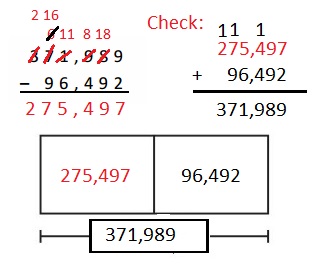
Explanation:
In subtraction if the minuend place values are less than the subtrahend then 1 is borrowed from the higher place value like
ones borrow from tens
tens borrow from hundreds
hundreds borrow from thousands
thousands borrow from ten thousands
ten thousands borrow from hundred thousands
hundred thousands borrow from million.
if there are successive place values less than the subtrahend we borrow from the highest place value whose value is higher than the subtrahend.
The number 371,989 is the minuend, the number 96,492 is the subtrahend and the number 275,497 is the difference.
c. 
Answer:

Explanation:
In subtraction if the minuend place values are less than the subtrahend then 1 is borrowed from the higher place value like
ones borrow from tens
tens borrow from hundreds
hundreds borrow from thousands
thousands borrow from ten thousands
ten thousands borrow from hundred thousands
hundred thousands borrow from million.
if there are successive place values less than the subtrahend we borrow from the highest place value whose value is higher than the subtrahend.
The number 371,089 is the minuend, the number 25,192 is the subtrahend and the number 345,897 is the difference.
d. 
Answer:
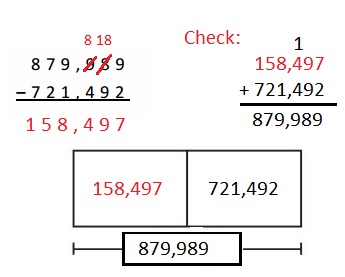
Explanation:
In subtraction if the minuend place values are less than the subtrahend then 1 is borrowed from the higher place value like
ones borrow from tens
tens borrow from hundreds
hundreds borrow from thousands
thousands borrow from ten thousands
ten thousands borrow from hundred thousands
hundred thousands borrow from million.
if there are successive place values less than the subtrahend we borrow from the highest place value whose value is higher than the subtrahend.
The number 879,989 is the minuend, the number 721,492 is the subtrahend and the number 158,497 is the difference.
e. 
Answer:
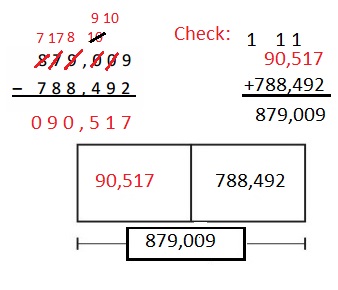
Explanation:
In subtraction if the minuend place values are less than the subtrahend then 1 is borrowed from the higher place value like
ones borrow from tens
tens borrow from hundreds
hundreds borrow from thousands
thousands borrow from ten thousands
ten thousands borrow from hundred thousands
hundred thousands borrow from million.
if there are successive place values less than the subtrahend we borrow from the highest place value whose value is higher than the subtrahend.
The number 879,009 is the minuend, the number 788,492 is the subtrahend and the number 90,517 is the difference.
f. 
Answer:
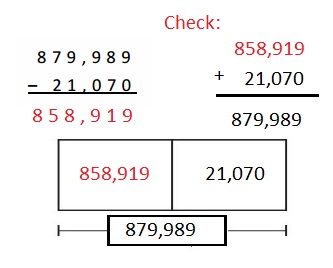
Explanation:
In subtraction if the minuend place values are less than the subtrahend then 1 is borrowed from the higher place value like
ones borrow from tens
tens borrow from hundreds
hundreds borrow from thousands
thousands borrow from ten thousands
ten thousands borrow from hundred thousands
hundred thousands borrow from million.
if there are successive place values less than the subtrahend we borrow from the highest place value whose value is higher than the subtrahend.
The number 879,989 is the minuend, the number 21,070 is the subtrahend and the number 858,919 is the difference.
g. 
Answer:
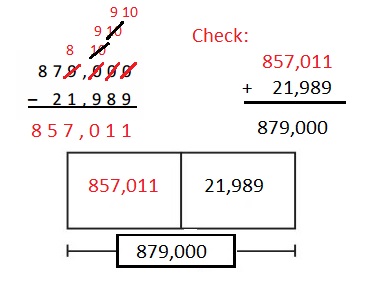
Explanation:
In subtraction if the minuend place values are less than the subtrahend then 1 is borrowed from the higher place value like
ones borrow from tens
tens borrow from hundreds
hundreds borrow from thousands
thousands borrow from ten thousands
ten thousands borrow from hundred thousands
hundred thousands borrow from million.
if there are successive place values less than the subtrahend we borrow from the highest place value whose value is higher than the subtrahend.
The number 879,000 is the minuend, the number 21,989 is the subtrahend and the number 857,011 is the difference.
h. 
Answer:
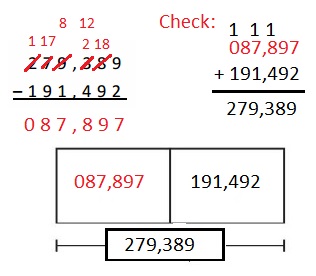
Explanation:
In subtraction if the minuend place values are less than the subtrahend then 1 is borrowed from the higher place value like
ones borrow from tens
tens borrow from hundreds
hundreds borrow from thousands
thousands borrow from ten thousands
ten thousands borrow from hundred thousands
hundred thousands borrow from million.
if there are successive place values less than the subtrahend we borrow from the highest place value whose value is higher than the subtrahend.
The number 279,389 is the minuend, the number 191,492 is the subtrahend and the number 87,897 is the difference.
i. 
Answer:
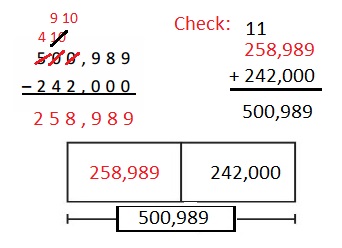
Explanation:
In subtraction if the minuend place values are less than the subtrahend then 1 is borrowed from the higher place value like
ones borrow from tens
tens borrow from hundreds
hundreds borrow from thousands
thousands borrow from ten thousands
ten thousands borrow from hundred thousands
hundred thousands borrow from million.
if there are successive place values less than the subtrahend we borrow from the highest place value whose value is higher than the subtrahend.
The number 500,989 is the minuend, the number 242,000 is the subtrahend and the number 258,989 is the difference.
Draw a tape diagram to represent each problem. Use numbers to solve, and write your answer as a statement. Check your answers.
Question 2.
Jason ordered 239,021 pounds of flour to be used in his 25 bakeries. The company delivering the flour showed up with 451,202 pounds. How many extra pounds of flour were delivered?
Answer:
Total flour ordered by Jason to use in his 25 bakeries = 239,021 pounds
Total flour showed by the company at delivering = 451,202 pounds.
Extra pounds of flour delivered by the company = A = 451,202 – 239,021
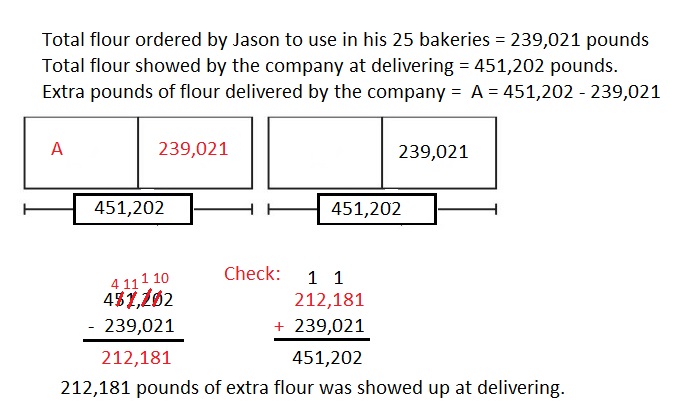
Question 3.
In May, the New York Public Library had 124,061 books checked out. Of those books, 31,117 were mystery books. How many of the books checked out were not mystery books?
Answer:
Number of books checked out from the New York Public Library = 124,061 books
Out of the checked out books the Number of Mystery books are = 31,117 books
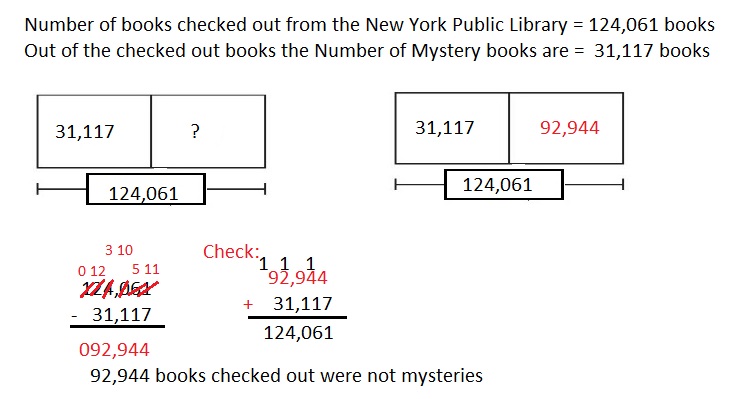
Question 4.
A Class A dump truck can haul 239,000 pounds of dirt. A Class C dump truck can haul 600,200 pounds of dirt. How many more pounds can a Class C truck haul than a Class A truck?
Answer:
Number of pounds of dust A Class A dump truck can haul = 239,000 pounds
Number of pounds of dust A Class C dump truck can haul = 600,200 pounds
The number of more pounds of dust A Class C truck can haul than a Class A truck = ?
